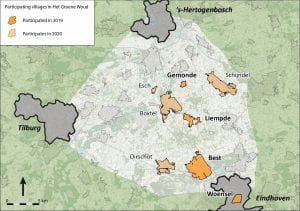In the Netherlands the CARE project focusses on Het Groene Woud, a region in the southern part of the country situated betw een the towns of ‘s-Hertogenbosch, Eindhoven and Tilburg. This area is characterised by a varied landscape with small villages and the occasional market town amidst old open fields interspersed with woodland, marshes and heathland with impressive driftsands. Because of the strong connection between natural and cultural history, the area has been declared a National Landscape.
een the towns of ‘s-Hertogenbosch, Eindhoven and Tilburg. This area is characterised by a varied landscape with small villages and the occasional market town amidst old open fields interspersed with woodland, marshes and heathland with impressive driftsands. Because of the strong connection between natural and cultural history, the area has been declared a National Landscape.
 Eight villages are committed to participating in the CARE project in the Netherlands in 2019-22: Best, Boxtel, Esch, Gemonde, Liempde, Oirschot, Schijndel and Woensel. These represent a variety of settlements in the region ranging in size from small to large, and in their state of historical preservation from good to almost unrecognizably subsumed within the suburb of a modern industrial town. Equally, their populations range from those with large proportions resident for several generations to those dominated by recent incomers with no historic ties to the village. This presents an excellent opportunity to learn about the capacity of participative archaeological explorations of the village’s past to strengthen people’s ties to their place (binding), to improve social cohesion (bonding) and connect people from various social groups (bridging).
Eight villages are committed to participating in the CARE project in the Netherlands in 2019-22: Best, Boxtel, Esch, Gemonde, Liempde, Oirschot, Schijndel and Woensel. These represent a variety of settlements in the region ranging in size from small to large, and in their state of historical preservation from good to almost unrecognizably subsumed within the suburb of a modern industrial town. Equally, their populations range from those with large proportions resident for several generations to those dominated by recent incomers with no historic ties to the village. This presents an excellent opportunity to learn about the capacity of participative archaeological explorations of the village’s past to strengthen people’s ties to their place (binding), to improve social cohesion (bonding) and connect people from various social groups (bridging).
In each of the villages the archaeological events are run by the local history or archaeology club.
